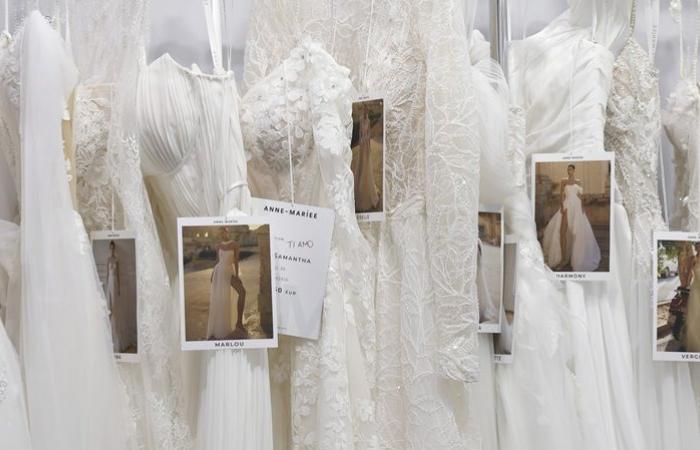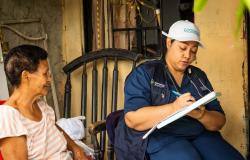The bridal industry takes chest. Historically linked to tradition, religious weddings and conventional celebrations or commercial designs of relative creative value, the sector has been working on the expansion of its horizons for several years: diversifying the offer of its brands, multiplying the possibilities of its silhouettes and opening space to new generations of brides, avant -garde links and diverse bodies. The brides have not disappeared, although they are less and different and plural, so the industry has been forced to adapt and renew to not die in stagnation.
In an inflationary context of macroeconomic uncertainty, with the changes in tariff policies such as the main threat, the recoil of China and the crisis of the luxury industry, which hits independent designers and large groups of the sector such as Kering and LVMH, the bridal cake seems more than sweet. According to the latest data published by The Business Research Company, the global market of Bridal It is currently valued at more than 69,000 million dollars And, in the next four years, it is expected to grow at a rate of 4% per year to exceed the 80 billion barrier in 2029.
Although in markets such as Spanish the Cotice Wedding Rate down, the bridal sector does not seem to stop growing in terms of business volume and International relevance. The Asia-Pacific region is the sector’s leaderconsolidated as the engine of the global business growth thanks to the increase in purchasing power, the rise of destination weddings and a strong cultural tradition linked to marriage. Currently, the area represents almost a quarter of the bridal business.
The global market of Bridal It is valued at more than 69,000 million dollars and, in the next four years, it is planned to grow at a 4% annual rate
For its part, the old continent fight to maintain its role as a historical epicenter of design, mainly in Spain, Italy, France and the United Kingdom, while the United States, one of the main markets in the sector, closes ranks before the measures of its president Donald Trump. Just a few weeks ago, Coinciding with the celebration of the New York Bridal Fashion Week, the main actors in the sector in the country signed a collective request so that the bridal industry is left out of tariff restrictions.
Without an official response at the moment, the American industry endures the throat knot that could put the sector in check: approximately, 90% of the fabrics used come from Asian countries such as China, Vietnam, the Philippines or Indiawhere the labor and the know-how Specific techniques such as embroidery or rhinestone inlays.
In the export level, China keeps the gold medal as the main export market Thanks to your experience and competitive model in productive speed and costs. India and Vietnam, on the other hand, are positioned on the podium of Asian producers; While Spain, Italy and France are strengthened as high -end exporters. In Europe, nuptial companies choose to compete in quality, design, crafts or sustainability, but face the impact of inflation, logistics costs and environmental regulation required in the continent.
The United States tariff crusade puts the sector in check, with fabrics from Asia and concentrated clothing in China
International demand is more heterogeneous. United States and Asia (with significant imports beyond China, in markets such as Taiwan, Japan, Vietnam, Hong Kong or South Korea)much of the cake are distributed, while the Middle East is oriented more towards the unique pieces of haute couture or luxury firms (with a lower volume of imports, but an outlay elevated by each piece). Europe, according to Eurostat data, shows a significant demand in Germany, France, Italy and Spain.
Through the celebration of the catwalk and professional fair Barcelona Bridal Fashion Week, The Catalan capital has been developing a strategic plan for years to raise its positioning and strengthen its role as international capital of bridal fashion, placing itself as the main European rival of the event Bridal New Yorker. “We have a fairly extensive capillarity, since we have participation of many countries from all continents in many countries, around forty,” explains the director of the event, Albasarí Caro, in an interview with fashion.
For the person in charge, “Barcelona is always in the spotlight“And, in the case of being in front of a polarization because of the measures in the United States, the city” will have very good letters to stay. “
Held between April 23 and 27, the latest edition of the bridal event celebrated its “most ambitious” edition to date, with a growth of 12% of its participation up to 450 brands from 32 countries, 44 designers in its parades and the 29% increase in the exhibition space of its usual location, in the Montjuïc enclosure. The visitors, meanwhile, rose to 23,500, 76% of them international.
Barcelona Bridal Fashion Week has just closed its largest and international edition
To boost its global role, the event was attended by 82% of foreign brands and opted for a program of foreign buyers from strategic markets such as the United States, South Korea, Australia or China. This bet was reflected in the feedback of multiple exhibitors during the fair, which this year was held for the first time in a separate pavilion. If Yolancris established contacts with Australian buyers and Isabel Sanchís affirmed his commitment to the Asian market, from the Canarian Marco & María celebrated the significant return of buyers from the Middle East and China. “Barcelona has placed over the years in one of the main fairs Bridal Worldwide, ”said Vanesa Cabeza, international sales head of the brand.
For her part, the Spanish designer Marta Martí, who this year celebrates the tenth anniversary of her brand, defended that “Barcelona is the center of fashion, also in the field Bridal“For the creative, the city is” a reference of the sector, and the Spanish textile industry remains one of the best, which attracts international buyers. “In their case, the main clients come from New York, Japan and South Korea.
The 2025 edition of the catwalk has suffered the absence of two great names of the Spanish bridal industry, Rosa Clará and Pronovias. Both companies have opted for another format of international commercial presentations or the organization of parades for strategic buyers in their own showrooms. Despite its strong media pull, its presence was not, however, surprised by much of the participants consulted. “Everyone is in Barcelona, even firms such as Stephane Rolland or Vivienne Westwood,” said Saioa Goitia, CEO of the Bilbao company Sophie et Boilà. The event address remains open to the possible return of the two brands in the future.
Vivienne Westwood, a definitive inflection point in the nuptial parades
After having built the strategic participation of international luxury firms and haute couture such as Marchesa, Viktor & Rolf, Elie Saab or Giambattista Valli in recent years, the participation of Vivienne Westwood marked, without a doubt, a turning point in the trajectory of the event. With a Night parade held at the Cloister of the University of Barcelona, The British firm presented its first parade dedicated only to its bridal line.
“The bridal world is tremendously different from that of parades in Paris, but I think brides reflect the power of clothing: Life is short and dressing is very useful, the garments change your mood and make your days better, ”said Andreas Kronthaler, creative director of the British brand, in the backstage After his parade. For the collection, the Austrian designer and widower of the firm’s founder, Vivienne Westwood, was inspired by the streets and avenues of Barcelona.
“I wanted to capture the city’s attitude in my girlfriends,” the creative said; We design wedding dresses for several decades, I realize that our looks remain more alive than ever and that can be reinterpreted with new tissues or slightly different cuts. ”Exponent of the upcycling and fashion punk As avant -garde in the London of the 1980s, Vivienne Westwood and his homonym firm are still more alive than ever.
“Now I am alone, but we were so many years designing together and doing everything halfway that I can no longer differentiate who I and who she is,” the Austrian acknowledged. In addition to being the protagonist of Barcelona Bridal Night, the firm showed its commitment to education, organizing a second show For students from IED, LCI and ESDI design schools. The brand will also establish mentoring projects in various disciplines.
Likewise, the Barcelona event celebrated the third edition of its sector awards, during which great names such as the Roman Giambattista Valli, Barcelona Teresa Helbig or the Valencian Isabel Sanchís were rewarded. The fair, which had a sophisticated space showroom Dedicated to the usual sewing signatures of the Fashion Week, Parisina aspires to progressively raise the positioning of the appointment, strengthening the belief that the bridal industry is not only a niche, but also fashion with its own name. In 2026, the event will return to Barcelona between April 22 and 26.






